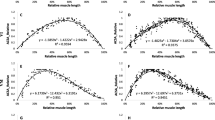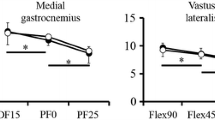Abstract
Purpose
This study aimed to clarify whether resistance training-induced changes in muscle architecture are homogeneous among the quadriceps and over different regions within each muscle.
Methods
Eleven recreationally active men (27 ± 2 years) completed a 12-week resistance training program for knee extensors. Before and after the intervention, muscle thicknesses, fascicle lengths, and pennation angles of the four muscles (vastus lateralis, vastus medialis, vastus intermedius, rectus femoris) in several regions (2–4 regions per each muscle) were measured using ultrasonography. Anatomical cross-sectional areas (ACSAs) at the same positions as the ultrasound measurements were determined from magnetic resonance images.
Results
Relative increases in the ACSA, muscle thickness, and pennation angle of the rectus femoris were significantly greater than those of the vasti. Relative increases in the ACSAs of the vastus lateralis and rectus femoris were significantly greater in the distal than in the proximal region, and those in the muscle thickness and pennation angle of the vastus intermedius were significantly greater in the medial than in the lateral region. Fascicle lengths did not change in any muscles. The interrelations between muscle thickness and pennation angle remained unchanged after the intervention, with a significant association between the relative changes of the two variables.
Conclusion
The current results indicate that (1) hypertrophy of the quadriceps femoris is associated with a proportional increase in pennation angle but not necessarily in fascicle length, and (2) training-induced changes in muscle size and pennation do not evenly occur among the quadriceps, along or across a muscle.







Similar content being viewed by others
Abbreviations
- ACSA:
-
Anatomical cross-sectional area
- VL:
-
Vastus lateralis
- VM:
-
Vastus medialis
- VI:
-
Vastus intermedius
- RF:
-
Rectus femoris
- SD:
-
Standard deviation
- 1RM:
-
One repetition maximum
- CV:
-
Coefficient of variation
- ICC:
-
Intraclass correlation coefficient
- MR:
-
Magnetic resonance
- MVCKE :
-
Maximal voluntary isometric knee extension
- MANOVA:
-
Multiple analysis of variance
References
Aagaard P, Andersen JL, Dyhre-Poulsen P, Leffers AM, Wagner A, Magnusson SP, Halkjaer-Kristensen J, Simonsen EB (2001) A mechanism for increased contractile strength of human pennate muscle in response to strength training: changes in muscle architecture. J Physiol 534:613–623
Akima H, Takahashi H, Kuno SY, Masuda K, Masuda T, Shimojo H, Anno I, Itai Y, Katsuta S (1999) Early phase adaptations of muscle use and strength to isokinetic training. Med Sci Sports Exerc 31:588–594
Akima H, Takahashi H, Kuno SY, Katsuta S (2004) Coactivation pattern in human quadriceps during isokinetic knee-extension by muscle functional MRI. Eur J Appl Physiol 91:7–14
Alegre LM, Jimenez F, Gonzalo-Orden JM, Martin-Acero R, Aguado X (2006) Effects of dynamic resistance training on fascicle length and isometric strength. J Sports Sci 24:501–508
Alexander RA, Vernon A (1975) The dimensions of knee and ankle muscles and the forces they exert. J Hum Mov Stud 1:115–123
Berg HE, Tedner B, Tesch PA (1993) Changes in lower limb muscle cross-sectional area and tissue fluid volume after transition from standing to supine. Acta Physiol Scand 148:379–385
Blazevich AJ, Gill ND, Zhou S (2006) Intra- and intermuscular variation in human quadriceps femoris architecture assessed in vivo. J Anat 209:289–310
Blazevich AJ, Cannavan D, Coleman DR, Horne S (2007) Influence of concentric and eccentric resistance training on architectural adaptation in human quadriceps muscles. J Appl Physiol 103:1565–1575
Bodine SC, Roy RR, Meadows DA, Zernicke RF, Sacks RD, Fournier M, Edgerton VR (1982) Architectural, histochemical, and contractile characteristics of a unique biarticular muscle: the cat semitendinosus. J Neurophysiol 48:192–201
Burkholder TJ, Fingado B, Baron S, Lieber RL (1994) Relationship between muscle fiber types and sizes and muscle architectural properties in the mouse hindlimb. J Morphol 221:177–190
Csapo R, Alegre LM, Baron R (2011) Time kinetics of acute changes in muscle architecture in response to resistance exercise. J Sci Med Sport 14:270–274
Ema R, Wakahara T, Mogi Y, Miyamoto N, Komatsu T, Kanehisa H, Kawakami Y (2013) In vivo measurement of human rectus femoris architecture by ultrasonography: validity and applicability. Clin Physiol Funct Imaging 33:267–273
Erskine RM, Jones DA, Maganaris CN, Degens H (2009) In vivo specific tension of the human quadriceps femoris muscle. Eur J Appl Physiol 106:827–838
Erskine RM, Jones DA, Williams AG, Stewart CE, Degens H (2010a) Inter-individual variability in the adaptation of human muscle specific tension to progressive resistance training. Eur J Appl Physiol 110:1117–1125
Erskine RM, Jones DA, Williams AG, Stewart CE, Degens H (2010b) Resistance training increases in vivo quadriceps femoris muscle specific tension in young men. Acta Physiol (Oxf) 199:83–89
Freilich RJ, Kirsner RL, Byrne E (1995) Isometric strength and thickness relationships in human quadriceps muscle. Neuromuscul Disord 5:415–422
Housh DJ, Housh TJ, Johnson GO, Chu WK (1992) Hypertrophic response to unilateral concentric isokinetic resistance training. J Appl Physiol 73:65–70
Ikai M, Fukunaga T (1968) Calculation of muscle strength per unit cross-sectional area of human muscle by means of ultrasonic measurement. Int Z Angew Physiol 26:26–32
Kawakami Y, Abe T, Kuno SY, Fukunaga T (1995) Training-induced changes in muscle architecture and specific tension. Eur J Appl Physiol Occup Physiol 72:37–43
Kawakami Y, Muraoka Y, Kubo K, Suzuki Y, Fukunaga T (2000) Changes in muscle size and architecture following 20 days of bed rest. J Gravit Physiol 7:53–59
Kawakami Y, Abe T, Kanehisa H, Fukunaga T (2006) Human skeletal muscle size and architecture: variability and interdependence. Am J Hum Biol 18:845–848
Kearns CF, Abe T, Brechue WF (2000) Muscle enlargement in sumo wrestlers includes increased muscle fascicle length. Eur J Appl Physiol 83:289–296
Kubo K, Kanehisa H, Kawakami Y, Fukunaga T (2001) Influences of repetitive muscle contractions with different modes on tendon elasticity in vivo. J Appl Physiol 91:277–282
Narici MV, Roi GS, Landoni L, Minetti AE, Cerretelli P (1989) Changes in force, cross-sectional area and neural activation during strength training and detraining of the human quadriceps. Eur J Appl Physiol Occup Physiol 59:310–319
Narici MV, Hoppeler H, Kayser B, Landoni L, Claassen H, Gavardi C, Conti M, Cerretelli P (1996) Human quadriceps cross-sectional area, torque and neural activation during 6 months strength training. Acta Physiol Scand 157:175–186
Richardson RS, Frank LR, Haseler LJ (1998) Dynamic knee-extensor and cycle exercise: functional MRI of muscular activity. Int J Sports Med 19:182–187
Rutherford OM, Jones DA (1992) Measurement of fibre pennation using ultrasound in the human quadriceps in vivo. Eur J Appl Physiol Occup Physiol 65:433–437
Seynnes OR, de Boer M, Narici MV (2007) Early skeletal muscle hypertrophy and architectural changes in response to high-intensity resistance training. J Appl Physiol 102:368–373
Seynnes OR, Erskine RM, Maganaris CN, Longo S, Simoneau EM, Grosset JF, Narici MV (2009) Training-induced changes in structural and mechanical properties of the patellar tendon are related to muscle hypertrophy but not to strength gains. J Appl Physiol 107:523–530
Takai Y, Ohta M, Akagi R, Kanehisa H, Kawakami Y, Fukunaga T (2009) Sit-to-stand test to evaluate knee extensor muscle size and strength in the elderly: a novel approach. J Physiol Anthropol 28:123–128
Thorpe SK, Li Y, Crompton RH, Alexander RM (1998) Stresses in human leg muscles in running and jumping determined by force plate analysis and from published magnetic resonance images. J Exp Biol 201:63–70
Wakahara T, Miyamoto N, Sugisaki N, Murata K, Kanehisa H, Kawakami Y, Fukunaga T, Yanai T (2012) Association between regional differences in muscle activation in one session of resistance exercise and in muscle hypertrophy after resistance training. Eur J Appl Physiol 112:1569–1576
Acknowledgments
This work was supported in part by the Grant-in-Aid for Young Scientists (B, #21700630 to T.W.) and for Scientific Research (#24300209) from Japan Society for Promotion of Science and by the Waseda University Global Centre of Excellence (GCOE) program, “Sport Sciences for the Promotion for Active Life”.
Conflict of interest
The authors declare that they have no conflict of interest.
Author information
Authors and Affiliations
Corresponding author
Additional information
Communicated by Michael Lindinger.
Rights and permissions
About this article
Cite this article
Ema, R., Wakahara, T., Miyamoto, N. et al. Inhomogeneous architectural changes of the quadriceps femoris induced by resistance training. Eur J Appl Physiol 113, 2691–2703 (2013). https://doi.org/10.1007/s00421-013-2700-1
Received:
Accepted:
Published:
Issue Date:
DOI: https://doi.org/10.1007/s00421-013-2700-1




